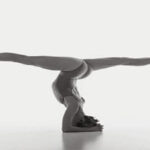8 GREAT YOGA BREATHING TECHNIQUES FOR SLEEP (1)
Getting proper sleep can be a challenge, especially during busy school or work week, or when life is full of pressure. If you want to improve your sleep quality and time, you can consider breathing exercises at night. Taking a few minutes to practice a calm and soothing breathing exercise can be a simple and powerful way to help you calm your mind, relieve your anxiety and relax your body to improve your sleep. Yoga provides several different breathing methods, which can help you to enter a deep and quiet state of relaxation and prepare yourself for sleep.
How breathing affects sleep
Breathing is one of the most basic ways for us to regulate our body and emotions, and it is also a key factor for our health and happiness. It is so important that our body even has a self-regulating mechanism-the respiratory system will automatically adjust the speed and depth of breathing to cope with external stimuli, such as sleepiness, stress, exercise and even emotional state.
Breathing is an important part of yoga, which has been used to change the energy flow in the body for hundreds of years. Pranayama uses the connection between breathing and autonomic nervous system to change our mental, emotional and energetic state.
1)Mouth vs. nose breathing
Oral breathing and nasal breathing have very different energy and emotional effects. Exhale through the mouth helps to release repressed emotions and pressures, and has a cooling effect on the body. Breathing through the nose is the most common method in yoga, because it can calm and concentrate. Usually avoid mouth breathing, because it will increase your heart rate and blood pressure, and trigger a stress response.
2)Belly breathing
Abdominal breathing is the basis of all pranayama exercises. Breathing into the abdomen joins the diaphragm and activates parasympathetic nervous system and natural relaxation response. Breathing in the chest requires more physical strength and is related to the pressure reaction of “fighting or running away”.
Similarly, shallow breathing can stimulate the brain and aggravate anxiety. Slow and deep breathing can calm, soothe and nourish. Slow diaphragm breathing can calm your brain, lower your heart rate and relax your body, which helps you relax and fall asleep faster. Yoga practice can also help you improve your sleep by resetting the default breathing mode, so that you can use abdominal breathing all night.
Counting with breathing
Rhythmic breathing exercises are a common part of many yoga exercises. Many people claim that calculating their breathing cycle with specific timing can improve their sleep, because it can make you focus on the calculation process. The main explanation for this is that prolonged expiratory time, or longer expiratory time than inspiratory time, is to calm and relieve stress. The most popular of these techniques is 4-7-8 respiratory ratio, which we will explain below.
Breathing exercises for sleep
The following seven breathing exercises can be done easily by yourself, which will help encourage you to relax physically and mentally and make your sleep easier. These pranayama can be practiced at any time, but it works best before going to bed. The best practice time is about 30 minutes to 1 hour before going to bed.
The following exercises are most effective for acute insomnia and temporary sleep interruption. Although yoga breathing is helpful for chronic insomnia, anxiety attacks and other sleep disorders, it cannot replace professional medical care or the help of qualified sleep experts.
3)Diaphragmatic Breathing
Diaphragmatic breathing is the basis of beginners’ study and practice. Also known as abdominal breathing, because in this method, when breathing deeply, the abdomen will rise and fall, while the chest will mostly remain stationary. This meditation breathing can relieve stress, promote relaxation, and improve vital capacity and efficiency.
4)Three-Part Breathing
For beginners, the three-part breathing method is perfect, which is traditionally called Dirga pranayama method and is based on diaphragm breathing. It is considered as one of the calmest breathing techniques, because it allows you to focus all your attention on how your breathing clears your mind through your abdomen and chest. Many people think that practicing this breathing technique regularly may relieve chronic stress and prevent panic attacks.

